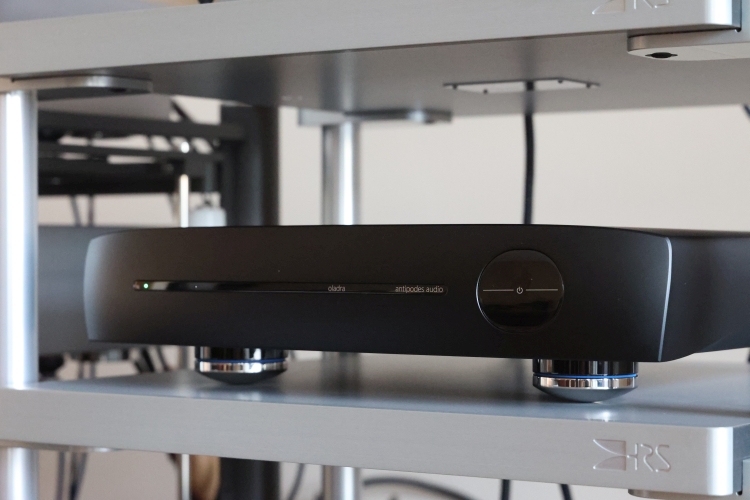Meridian Sooloos Media Core 200
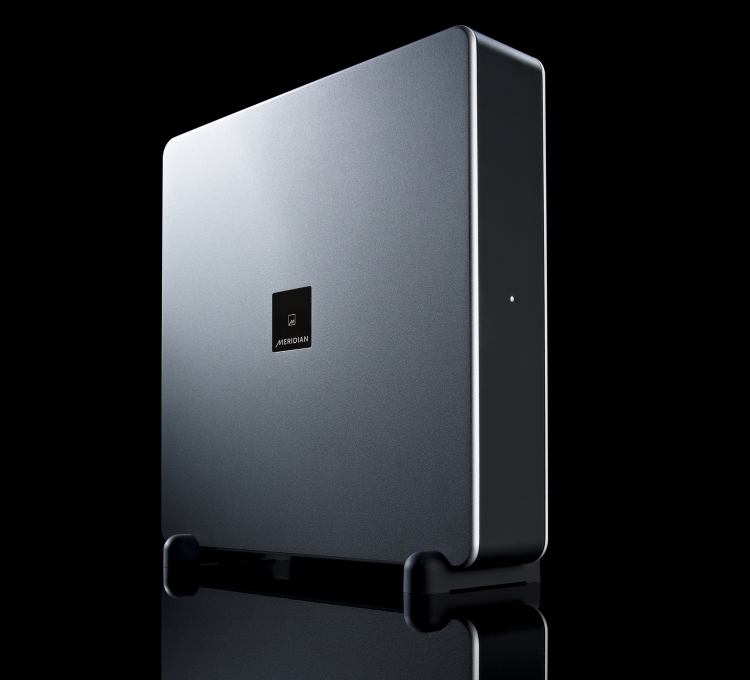
Combination of Sooloos server and endpoint in one neat and compact package
Meridian describes this unit as follows: “The Meridian MS 200 is an elegant, compact and virtually silent Meridian Sooloos Digital Media System that requires only your choice of controller to bring it to life”. That does sum it up quite nicely. The controller in question can be a PC running ControlPC software, a Mac running ControlMAC software, an iPad, iPhone, or iPod running the CoreControl app, or another Sooloos controller. By substantially lowering the Sooloos entry price, Meridian has entered a market where every music enthusiast can afford to enter the experience. Read on for the full review, but I can already tell you right now that I want one. And after trying it out for yourself, you’ll probably want one too!
Review sample supplied by Dutch distributor Viertron
Retail price approx 2750 euro
Note: the Sooloos name has now changed into “Meridian Streaming Audio”.
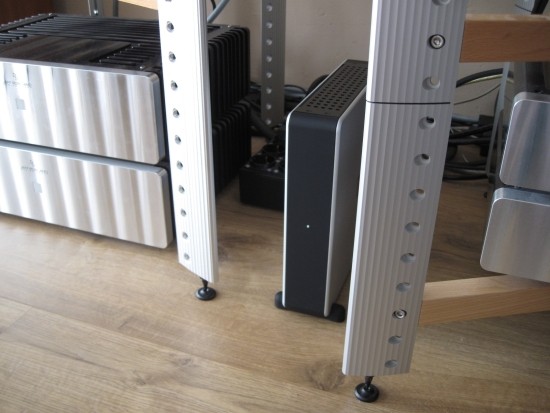
Background
Regular readers know that I don’t usually spend much time dicussing the operability and options of any device, and instead go straight to the listening tests. After all, that is what interests me most. In this case, I need to make an exception to this routine because the MC200 is all about functionality and user-friendliness. The MC200 sets the benchmark for intuitive control over your music collection so extremely high, that it just creates an enormous gap between it and all other network-audio products that I have tested thus far. So, what makes the MC200 so special?
For starters, that it is not your typical UPnP streamer. In fact, it’s not a streamer at all. Instead, think of the MC200 as a dedicated audio server. The unit itself can be seen as one zone with analog and digital outputs but it can send separate audio streams to many zones simultaneously. For that to work, all that’s needed is to install the freely available ControlPC or ControlMac software. This software allows access to all import and export settings as well as full database access and playback, even controlling playback to other zones. What is most distinctive however is the way that you navigate through your collection. It lightly resembles iTunes in the way that you swipe left and right with extremely smooth movement. Naturally, you can just browse the directory as it exists for example artist folder containing album folder containing tracks, or go by album, by artist or by song, but it goes so much further than that.
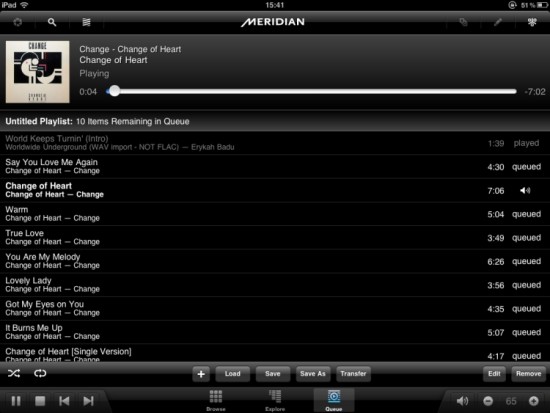
You can also browse through recently imported items, last day, last week etc. Then there’s the very capable search functionality: free search, artist search, album search etc, and this also works if you type “Johnson” if you’re looking for Don Johnson. No need to start with the first letter. There’s more. When you import a CD, it is automatically compared against a database that not only contains the usual tags such as artist, album and track titles, it also adds tags such as “producer”, “musicians”, “writers”, and moods such as “positive”, “contemplative” or “easy”. It also collects a review and much more. All these attributes can then be searched for. Once a match is found, you are automatically presented with all this info, as well as more albums from the same artist. From there you can choose to play the entire search result, only select albums or single tracks, right now, after the current track, or at the end of the current playlist.
ou can also set a “focus” on this style, or even on a combination of this style and another style that matches other tags, and save the results for later. From this focus, you can then choose to make a playlist or just shuffle through it, called “swim” in Meridian lingo. Swim works much in the way that Wincue works for Winamp: whenever your playlist runs out, it will auto cue another track either randomly, or from a set of rules. Meridian even goes a step further, allowing a playlist with a mix of defined oder and swimming in-between. For example, when you are listening to a playlist and hear something you like, you can search for other music like it, and select “swim in this artist”. The MC200 will then play all the tracks by this artist (or a selection if you have track picks, or track deletions) and once done, resume with the rest of the playlist.
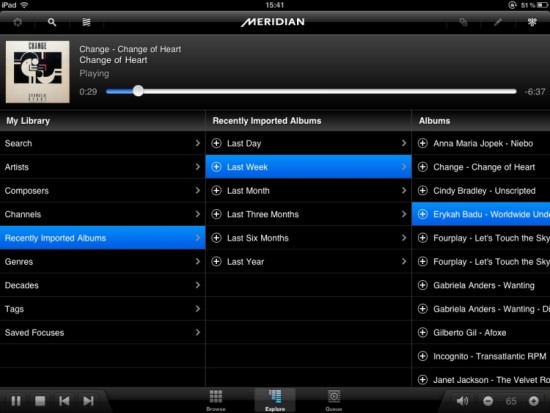
What’s more, even though WAV files normally don’t contain tags, the MC200’s internal database takes care of that, making WAV files appear precisely the same as FLAC or any other fully-tagged format. I haven’t even gone all the way describing the extended functionality, but it should be obvious by now that the navigation is simply state of the art.
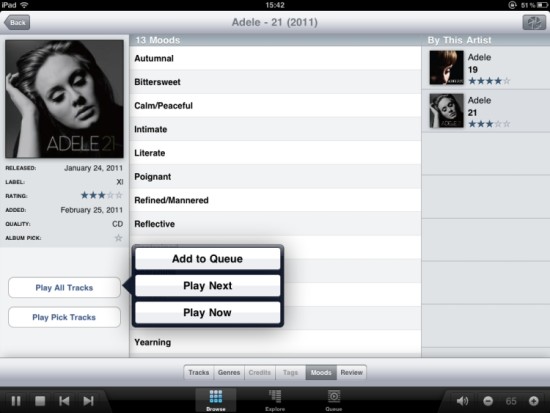
Oh, one more thing: connectivity is utterly stable and entirely problem-free. Connect to the network and the Core Control utility for iPad will find the MC200 within seconds every time. How different from the Linn Klimax that frequently needs a restart after the network cable has been swapped, or the PS Audio PWD, that always goes through a routine of keeping me waiting for a long period before it finds the connection, only to drop it 5 times after that, before becoming stable. Other manufacturers take note: this is how it should be done!
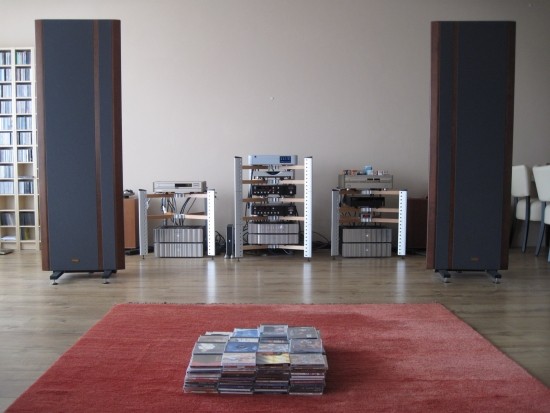
Sound
There’s a setting in the Config software (for Windows only) where you can choose “force 1x samplerate”. This forces the MC200 to play the various files in their native samplerate, which is 44.1 for CD’s. Disabling the option makes the unit upsample 44.1 to 88.2 but leaving high res files untouched. This upsampling is apparently done by means of Meridian’s proprietary apodizing filter, although I can’t really understand the practical implementation of apodizing when upsampling, it is clear that this setting produces a much better sound. Bass becomes fuller, midrange richer, treble more fluid and soundstage wider. The only thing that could count in favor of 1x samplerate is that bass is slightly tighter and transients sharper. But for me that is no argument, as I like my music presented rich and full, and I find the MC200 articulate enough even when upsampling to 88.2, so the addition of some richness is only welcome. This is probably the factory default so my advice would be not to touch it. Of course, I experimented with powercables. The MC200 turned out not only to be sensitive to extensionblock position, but also for the type of power cable feeding its external power adaptor, sounding noticeably fuller with a Lapp cable than with the standard supplied cable. I have separately powered extensionblocks: one with Lapp, the other with solid core installation wire. This also mattered for the MC200 and I liked it best using the Lapp-powered extensionblock, for its more expansive and organic sound. The MC200, powered this way, and using its own analog outputs doesn’t really put a foot wrong and actually sounds pretty decent, more or less on par with a modern Meridian CD player at the same price point, although the older Meridian 506.24 admittedly sounds fuller in the bass, with more fluid and airy treble and an overall more organic and effortless presentation. You’d think that this could be just the nature of computer audio, but you’d be proven wrong as soon as you connect the MC200’s coaxial digital output to a good DAC.
External DACs
The first DAC I tried was the Levinson no. 360S. And that made a world of difference. Bass became fuller and more solid and the whole impression was of a much more powerful and dynamic presentation. But treble remained as it was: smooth, but not extremely airy on top. Still, this sound reminded me a lot of how my Levinson 390S cd player sounds. So much so in fact, that it wouldn’t be immediately obvious if I walked in the room, to guess which machine was playing. When directly comparing the two it is clear however that the cd player still has the edge in bass depth and solidity, midrange organicness and treble fluidity and air. But it is very recording-dependent. Some cd’s simply sounded so good on the MC200 via 360S DAC, that I had no urge to switch away at all. I then tried the PS Audio PWD which I like very much for its Wadia-like solidity and soundstage. It does this with help of its digital lense circuit, which makes the most out of even a jittery source. And sure enough, the MC200, when connected digitally to its coax input, sounded a lot more dynamic and lively than it did through the Levinson 360S DAC. But I kind of missed the smoothness and liquidity, for which I loved the MC200 from the start. Connected through the Levinson 360S DAC, it just sounds very real and entirely unaggressive, and not at all computer-like. But there is a touch of restraint about the MC200, something that makes me question its power supply or regulation. It’s almost as if sometimes it just doesn’t give it all, in terms of bass slam and dynamics. This feeling is confounded when connecting other sources to the same Levinson no. 360S DAC, such as the Levinson no. 390S CD player, or even the Meridian 506.24. Both players have bigger bass and a more generous soundstage as well as an overall more organic feel. Play hi-res recordings, however, and the MC200 simply shines, becoming smoother and more detailed and making a strong case for high res recordings.
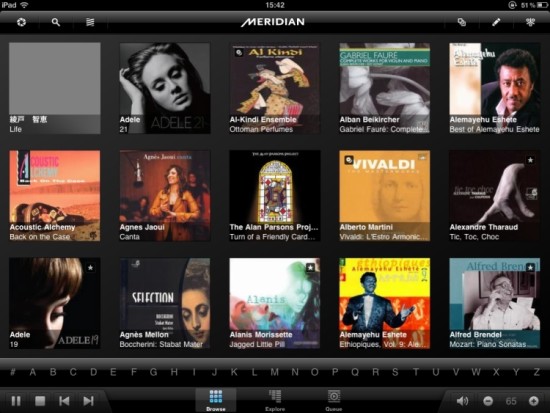
Compared to regular computer playback
I directly compared the MC200’s coaxial output to that of my regular computer setup, which uses an M2Tech HiFace EVO USB-S/PDIF interface. This represents the best I have been able to achieve in regular computer playback (ie not streaming). Naturally, I used the same CDs (both in WAV format) and connected both sources to the same Levinson no.360S DAC. There are differences, but I can’t say for sure which machine I like best. My computer using the HiFace EVO has better air and a more open sound overall, as well as bigger, fuller bass. The MC200 however has a tighter, more articulate sound. Also, after listening to the MC200 a little longer, and switching back, the computer setup sounds a little artificial, less acoustical so to say. Not a bad score for the MC200 I’d say!
Compared to computer playback in another setup
I also took the Meridian MC200 to a friend’s place. He has Martin Logan speakers, Jeff Rowland amplification, and a dCS digital front end. First, we listened to his regular computer audio playback. This is done with a standard tower PC, similar in spec to my own, and using the M2Tech HiFace EVO USB/S/PDIF interface, feeding S/PDIF coaxially into the Purcell upsampler, then into the Delius DAC. When comparing directly to the MC200, the differences turned out to be quite different than in my own setup. While my own computer had fuller bass than the MC200, in this setup the Meridian had better bass as well as an overall fuller, more realistic sound. However, again evident was the MC200’s lack of treble extension. In this setup, this was even clearer than in my own because these aging Martin Logans don’t really do extreme treble very well. My Magnepan’s pure ribbons however have extremely well-extended treble and can thus make up for some loss elsewhere in the chain. Still, in this other setup, we both preferred the MC200, playing digitally into the dCS Delius/Purcell stack. By the way, we used two digital interlinks. First his Transparent Premium, my Wireworld Gold Starlight III. The latter turned out to be the better match, revealing the Transparent as thin and gray, even if it had better transients and attack. The Wireworld was simply much more organic and presented the music with more color, in a wider soundstage.
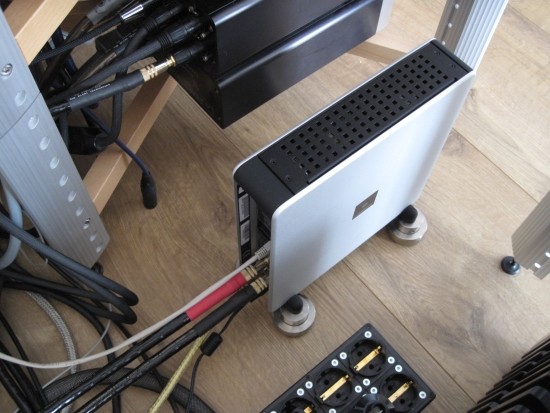
Above: In spite of its small size, the connectors are well-spaced out, allowing even the big Cardas snakes to fit comfortably.
Placement
Some people might frown upon hearing this, but the MC200 is sensitive to where it is placed. Use its plastic/rubber feet and it will sound quite smooth, but not optimal in the bass. Place the MC200 with its own feet on top of Cerapucs and you get more dynamic slam. Place the MC200 with its housing directly on top of the Cerapucs, bypassing its plastic/rubber feet and the sound becomes even tighter and articulate, but you also lose some of the treble fluidity. So, just know that this leaves room for experimentation, which I feel is always good. After all: tailoring the sound to our liking is what us audiophiles love to do isn’t it?
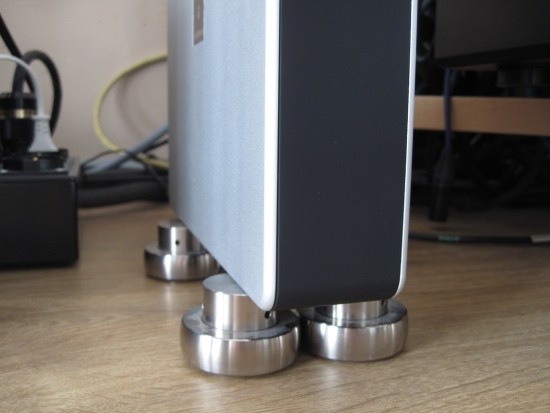
Above: Placement with Cerapucs directly under the MC200’s chassis made for the most powerful sound, but it can also tilt a little toward a dry sound. Experiments are worth the effort! Do note that one doesn’t have to use Cerapucs, or any of the Cera family of products, to hear differences like this. Regular hard material spikes will also make an audible difference.
USB connections
The manual states that the USB connectors only work for Meridian-approved extensions, such as a Wi-Fi receiver or a Microsoft Media Center-compatible IR receiver for use with the company’s MSR+ controller. Using that, you gain control over previous/next track, volume and play/pause. Of course, I tried connecting the MC200 via USB to the PS Audio PWD DAC. But alas, no luck. Also, connecting USB sticks or hard drives is out of the question. You’re stuck with the 500GB built-in hard drive. On that note: 500GB is quite a lot of space. As long as you don’t have too many high res files and only store what you really want, you’re not likely to exceed that limit any time soon. I have been collecting music files for many years now and am now approaching the 500GB mark. For me, this disk would suffice right now, and probably for some time to come, but sooner or later ‘I’d reach its limit. I know people who simply collect everything and anything and these people tend to have huge collections. For these people, additional storage might be necessary. And that extra storage can only be obtained from Meridian, in the shape of a Twinstore or Media Drive 600.
File formats
From looking at the iPad interface, the MC200 isn’t very clear about what format it is that is played. FLAC and WAV are both considered “CD”. However, it quickly became clear that FLAC sounds pretty different from WAV. I’ve noticed this before but had high hopes that in the case of the MC200 this would be a non-issue, but alas, it still is. Import CD’s using the “import CD” button on the ControlPC application, and you end up with a FLAC. Import the same CD, ripped on the PC first, then imported using the “import folder” button on the ControlPC application, and you end up with WAV. It takes only little time before you realise that WAV sounds more dynamic and lively and FLAC more rounded and supple. Now whether you prefer one or the other is a personal matter. But I can’t understand that Meridian continue to claim that FLAC=lossless=equal to CD. Maybe the bits are equal, but the sound isn’t. With the MC200 I feel that this is very important because due to its slight restraint, you’d want to get the maximum out of it in terms of dynamics and slam.
Wish List
1. Increase disk size to 1TB. For me the MC200’s 500GB space would soon be entirely filled.
2. Importing a CD can only be done in FLAC. I’d like the option to go for WAV, too. Metadata is no problem because the MC200’s internal database takes care of that.
3. The possibility to delete individual tracks. All you can do is flag them to not play unless selected, which means that the track won’t play when playing the CD in order or in swim mode. You can however delete the entire CD. According to Viertron this is because the music isn’t stored as individual tracks but as one FLAC file per CD, increasing access times and overall speed.
4. Have the iPad app also display samplerate, bitrate and actual format (WAV/FLAC), not only CD or hires. According to Viertron, most customers aren’t interested in these details. I suggest to include the option for this in settings.
5. Manually selectable standby or sleep mode for the hard drive. According to Viertron, this isn’t done in order to keep access times to a minimum. It doesn’t have to be an auto-sleep function, but I’d like to option to choose sleep, instead of shutting down.
6. Add pre-selection of default action (cue or play now) when clicking a track or cd. By this I mean that you don’t always have to click twice for a track to play, but have a default action that you can define once beforehand.
7. Add the possibility to overwrite the current (unsaved) playlist with a new selection (an entire CD or a focus-result). This means that in one go, you can delete the current playlist entries and add new ones.
Problems
1. When importing WAV files ripped with dB Poweramp via the ControlPC app’s “import folder” function, for roughly 30% of the imported files there is loud noise at the last second of each track. This is not the case when playing back these same files in iTunes or Winamp, nor when importing the CD directly using ControlPC’s “import CD” function. This problem has been reported and will be dealt with. Update 30-6-2012: it turns out that the loud noise is in fact the meta data chunk, added to the WAV file by dB poweramp, that the Meridian cannot deal with. Instead of reading the data and skipping it on playback, it actually plays this data chunk. Further experimentation showed that AIFF files with the same meta data tags made in dB poweramp do not exhibit this problem. So, I converted all my WAVs to AIFF and the problem was solved. nb: the Meridian does read the information in the tags.
2. The playlist occasionally doesn’t show the individual entries, only a total number of tracks in the CoreControl app (see image above). Restarting the MC200 and (hard-booting) the CoreControl app will solve this. Update 30-6-2012: since the new version of Core Control for the iPad I haven’t seen this behaviour anymore. It may just have been fixed!
3. CoreControl will occasionally crash when browsing through artwork for too long. This is most likely an iPad memory problem. Restarting the MC200 and (hard-booting) the CoreControl app will solve this. Update 30-6-2012: a new version of Core Control for the iPad addressed this issue and I haven’t seen a crash since.
To take into account
Auto-tagging works really well and is entirely problem-free with CD’s. It even works well on WAV files if they sit in the correct folder structure, but only as long as you have all the tracks that were originally on the CD. If you only have a selection of tracks, the auto-tagging is likely not to find a match.
CD’s are really only imported without problems if imported integrally, meaning no tracks are left out.
Conclusion
In spite of my reservations described above, the MC200 just screams BUY ME to me. I want one and I want one now. The MC200, or more precisely, its navigation system, is a joy to use and an example for others. Sound quality using the built-in DAC is good, on par with modern CD players in this price range, but its real potential is shown when used with a high-quality external DAC, such as the Levinson no. 360S. Connected that way, the MC200 sounds smooth and decidedly un-digital. It isn’t “impressive” sounding in audiophile terms but simply makes music in a manner that is never tiring. You can listen to it for hours at end.
A comparison with other big names in streaming audio places the MC200 smack in the middle for absolute sound quality, with the Linn Klimax DS excelling on audiophile qualities such as low-level detail, focus, refinement, and air but not necessarily being emotionally as appealing, and the PS Audio PWD offering more solid and rhythmic bass, more explosive dynamics and bigger and more finely layered soundstaging, but having rough treble that also lacks air and finally the Naim NDX offering more excitement and attack but with an overall much less refined sound. Then to think that all these streamers are a lot more expensive than the MC200, the Klimax even obscenely so.
Comparing in hindsight to the more similarly-priced Olive 04HD, I think that the latter had better bass power and dynamics, but the MC200 is definitely smoother and more refined, not to mention that its navigation is way superior to that of the Olive, which is in all honesty merely adequate. At its price level, I can only conclude that the MC200 is, quite simply, without peers.
In summary: even taking absolute sound quality and the 500GB disk limit size into account, it is so much fun that I’d still very much want to have one. What’s more: the MC200’s performance makes me wonder what the Media Source 600/Media Drive 600 combo can achieve with their separate power supplies and more elaborate, balanced output stage. Now if only I could convince Viertron to send me the pair and let me keep them as a reference for others to judge by…







